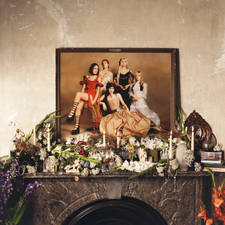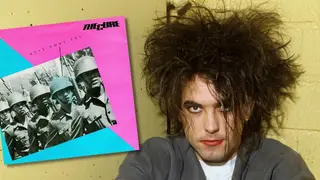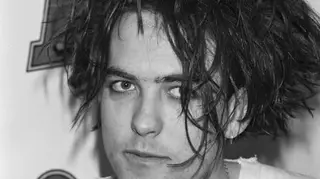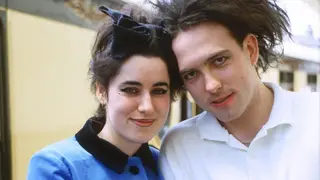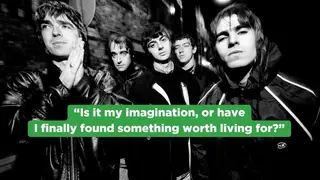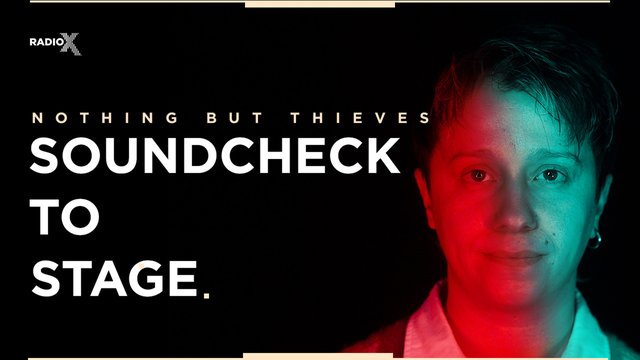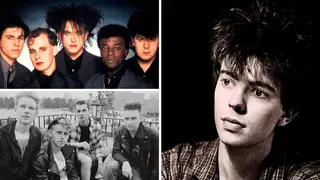14 things you didn't know about The Cure's Disintegration album
2 May 2024, 08:00 | Updated: 8 May 2024, 11:42

Released on Tuesday, 2nd May 1989, Disintegration is considered by many to be The Cure's masterpiece. With tracks like Pictures Of You and Lovesong, it's one of the band's best-loved records - even though the label wasn't impressed at the time...
Listen to this article
-
The album's lyrics are about Robert Smith turning 30
Smith was set to reach that momentous age on 21st April 1989, prompting him to write a series of lyrics that expressed fears of ageing, time moving on and relationships ending. The finished album was more serious and introverted than its eclectic predecessor, Kiss Me Kiss Me Kiss Me.
-
40 songs were written and rehearsed for the album
Disintegration was The Cure's first set of new material in two years, so the band decamped to drummer Boris Williams' house in Devon to write and record a set of demos. According to the "Prayer Tour" programme, there were 40 musical ideas created for the album, 30 of which were earmarked for further work, and 12 of these made it to the finished album. Four songs - Babble, Out Of Mind, 2 Late and Fear Of Ghosts - were kept as b-sides.
Smith said of these sessions in the deluxe edition of Disintegration: The atmosphere was great at Boris's house. We created our own strange, sall world, insular and intensely surreal. It was an understandable reaction to how seriously big all things Cure had got with the success of the Kiss Me album and tour."
The Cure - Disintegration album artwork. Picture: Alamy -
Disintegration was to be the last album featuring founder member Laurence Tolhurst
The Cure were formed in the early 1970s when Robert Smith and Laurence "Lol" Tolhurst first met at school. Originally the band's drummer, Tolhurst moved to keyboards in 1982, but this signalled the beginning of a long, tragic decline as the musician struggled with alcohol. In his honest memoir Cured, Tolhurst recalled that much of the Disintegration sessions were spent "idly sat outside the control room, waiting for inspiration to come."
During a playback of the final album just before Christmas 1988, Lol told Robert and the rest of the band that he thought "Half is good, but half is sh*t!" Three weeks later, Smith sent a letter to Tolhurst saying he wasn't invited to join the band on their upcoming world tour and that he was no longer part of The Cure. On the album cover, Tolhurst's contribution is cryptically listed as "Other instrument".
Smith told the NME in 1989 that Tolhurst's drinking had become a liability: "He was drinking so much, he was the only one who couldn't moderate to any degree. He was out of step with everythig. I think he was shocked by it, everyone was shocked that I actually meant it."
Lol Tolhurst, with The Cure in 1986:Simon Gallup, Boris Williams, Porl Thompson, Tolhurst and Robert Smith (front). Picture: Alamy -
Disintegration includes The Cure's biggest hit in both the UK and the USA
The first single from Disintegration in the UK was Lullaby, released on Monday 10th April 1989. It peaked at Number 5 in the band's native country. Meanwhile, the second single from the album, Lovesong, was issued in August that year and crept up the Billboard Hot 100 until it peaked at Number 2 in the week ending 21st October. Janet Jackson’s Miss You Much kept it off the top spot. The song started life as a wedding present for Smith's wife Mary, who he married partway through sessions for the album, in August 1988.

The Cure - Lovesong
-
Pictures Of You is about a fire at the studios where The Cure were recording
The Cure decided to record the album at Outside Studios, now known as Hook End, just North of Reading in Berkshire. On the first night in residence, an electrical fault in Robert Smith's room started a fire, leading to a complete evacuation of the premises. Complete, apart from Robert Smith, who dashed back to retrieve the bag that held all the lyrics he'd just written for the new songs. His personal effects were signed by the flames, including some photographs of his long-term partner Mary, which inspired the song Pictures Of You.

The Cure - Pictures Of You
-
There were two different lead singles in Britain and America
While the UK's first glimpse into the world of Disintegration was the creepy world of Lullaby, it was felt that the American market wouldn't go for such an idiosyncratic single, therefore the rockier Fascination Street was issued Stateside, with the same b-sides that appeared on the Lullaby package.

The Cure - Fascination Street
-
Robert Smith was nearly banned from appearing on Top of The Pops
The video for Lullaby was an excellent piece of Gothic horror directed by The Cure's long-term collaborator Tim Pope, who had Robert Smith dressed up as the ghastly "spider man" and eaten by a huge arachnid at the climax. When the BBC's Top Of The Pops called, wanting The Cure to perform their hit single on the 20th April 1989 edition of the chart show, Smith decided to adopt the thick, black "spider man" make-up.
However, an alarmed producer demanded that the singer tone down his look, the band threatened to walk off the show. Thankfully, the performance went ahead - but notice there are no close-ups of Robert's terrifying visage. "At least we still threaten peopple," Smith laughingly told Melody Maker. "That has to be a good thing."

The Cure - Lullaby - TOTP - 1989 [Remastered]
-
There are some hidden messages on the album
Smith told the NME at the time that Disintegration was a deliberate call-back to earlier Cure albums. "Lyrically, Disintegration has echoes of the past on purpose. I think it's on The Same Deep Water As You that I whisper 'Your name like ice' which comes from Cold on Pornography. We've mixed some of the more obvious ones out, it was just like spot the clue."
The Cure - minus founding member Lol Tolhurst - at the 1989 MTV Video Music Awards: Smith, Thompson, Roger O'Donnell, Williams and Gallup. Picture: Jeff Kravitz/FilmMagic, Inc/Getty -
One of the b-sides is one of Robert Smith's favourite songs
Smith claims that 2 Late, the flip of Lovesong, is a personal highlight among The Cure's massive back catalogue. He said in the sleevenotes to the b-sides collection, Join The Dots: "I was so sure it would be a single, but very early on the album took on a life of its own and 2 Late just never seemd to quite fit in."

2 Late
-
The record company wasn't pleased with Disintegration
In contrast to the lively pop songs that appeared on the Kiss Me album, Disintegration's morose atmopshere didn't please PolyGram who owned the label that The Cure were signed to, namely Fiction. Smith explained in the sleevenotes to the Disintegration deluxe edition: "Although the overall mood of the album was pretty downbeat, there was so much string, immediate melody and interplay in songs like Pictures Of You, Lullaby and Lovesong, the record company couldn't hep but recognise Disintegration as the perfect Cure album. It was a bit of a shock to find they didn't."
Despite being told it was "commercial suicide", Disintegration made Number 3 in the UK, Number 12 in the US, and went Top 5 in France, the Netherlands, Austria, Belgium, Germany, Ireland, Spain and Switzerland. The LP has gone Gold in the UK and double Platinum in America.
Robert Smith onstage with The Cure on the Prayer Tour, 1989. Picture: Alamy -
The making of Disintegration stopped The Cure from recording the soundtrack to Edward Scissorhands
Keyboardist Roger O'Donnell recalls seeing the script to Tim Burton's movie lying around the studio as the band recorded, and the prospect of The Cure soundtracking the tale of the misfit teenage boy seems like a perfect fit. However, the new Cure album took priority and Burton was only then known for the underground hits Pee-wee's Big Adventure and Beetlejuice, so the collaboration never happened.
Edward Scissorhands poster. Picture: Alamy -
The original vinyl edition was missing two tracks
The finished album ran to over 70 minutes in length - the perfect amount of time for the then-relatively new medium of Compact Disc. However, if you bought Disintegration on vinyl in May 1989, a single disc couldn't take this amount of audio without severely compronising the sound quality, therefore two songs - Last Dance and Homesick - were removed from the running order and were only available to those who bought the CD or cassette versions. When the album was reissued in 2016 on vinyl, the music was spread across two discs and included the two previously-missing tracks.
-
The Prayer Tour was the biggest outing for The Cure to date
The 76-date "Prayer Tour" begain in Roskilde, Denmark on 1st May 1989 and wound up almost five months later at Mansfield, Massachusetts on 23rd September, with a stop off at Dodger Stadium. The end of the show featured a rare appearance of The Cure's improvised jam Forever, which climaxed with Robert Smith apparently claiming that it was the final Cure show of all time, announcing: "Thank you very much and good night. And I'll never see you again."

The Cure - Plainsong - Los Angeles, Dodger's Stadium (75,000 fans)
-
A live album was released of the Wembley shows
The Eurpean leg of the Prayer Tour climaxed with three nights at the old Wembley Arena: 22nd, 23rd and 24th July 1989. The shows were recorded and the Disintegration tracks were later issued as a cassette and CD called Entreat. At first the album was issued as a promo in French record stores, then became availble via HMV shops - if customers bought two albums or CDs from the Cure's back catalogue. The album was later given a full commercial release and now forms part of the Disintegration "delxue edition" CD.

The Cure - Disintegration (Disintegration Entreat Plus Live)
